Greater East Asia Co-Prosperity Sphere
The Greater East Asia Co-Prosperity Sphere (Japanese: 大東亜共栄圏, Hepburn: Dai Tōa Kyōeiken), or the GEACPS,[1] was an imperialist concept which was developed in the Empire of Japan and propagated to Asian populations which were occupied by it from 1931 to 1945. It extended across the Asia-Pacific and promoted the cultural and economic unity of Northeast Asians, Southeast Asians, South Asians and Oceanians. It also declared the intention to create a self-sufficient bloc of Asian nations which would be led by the Japanese and this bloc would also be free from the rule of Western powers. The idea was announced in a radio address which was titled "The International Situation and Japan's Position" and delivered by Foreign Minister Hachirō Arita on 29 June 1940.[2]
| Greater East Asia Co-Prosperity Sphere | |||||
|---|---|---|---|---|---|
| Japanese name | |||||
| Kana | だいとうあきょうえいけん | ||||
| Kyūjitai | 大東亞共榮圈 | ||||
| Shinjitai | 大東亜共栄圏 | ||||
| |||||
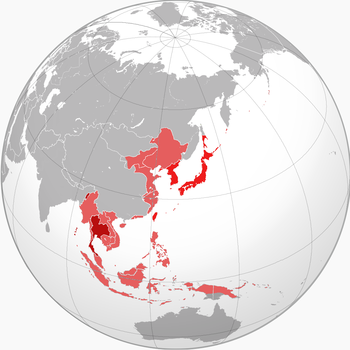
The intent and practical implementation of the Greater East Asia Co-Prosperity Sphere varied widely depending on the group and government department involved. Policy theorists who conceived it, as well as the vast majority of the Japanese population at large saw it for its pan-Asian ideals of freedom and independence from Western colonial oppression. In practice, however, it was frequently used by militarists and nationalists, who saw an effective policy vehicle through which to strengthen Japan's position and advance its dominance within Asia.[3] The latter approach was reflected in a policy document released by Japan's Ministry of Health and Welfare, An Investigation of Global Policy with the Yamato Race as Nucleus, which laid out the central position of Japan within the Greater East Asia Co-Prosperity Sphere,[4] and promoted the idea of Japanese superiority over other Asians.[5]
Development of the concept
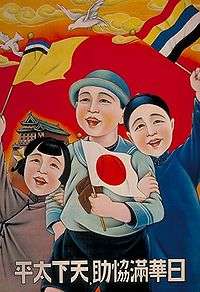
Much as the term "Third Reich" was a military exploitation of a non-military term proposed by Arthur Moeller van den Bruck, the phrase "Greater East Asia Co-Prosperity Sphere" was proposed by Kiyoshi Miki, a Kyoto School analytic philosopher who was actually opposed to militarism.
An earlier, influential concept was the geographically smaller version of the co-prosperity sphere which was called New Order in East Asia (東亞新秩序[6], Tōa Shin Chitsujo), which was announced by Prime Minister Fumimaro Konoe on 3 November 1938 and was limited to Northeast Asia only.[7]
The original concept was an idealistic wish to liberate Asia from the rule of European colonial powers, however, some Japanese nationalists believed it could be used to gain resources which would be used to ensure that Japan would continue to be a modern power, and militarists believed that resource-rich Western colonies contained abundant supplies of raw materials which could be used to wage wars.[8] Many Japanese nationalists were drawn to it as an ideal.[9] Many of them remained convinced, throughout the war, that the Sphere was idealistic, offering slogans in a newspaper competition, praising the sphere for constructive efforts and peace.[10]
Konoe planned the Sphere in 1940 in an attempt to create a Great East Asia, comprising Japan, Manchukuo, China, and parts of Southeast Asia, that would, according to imperial propaganda, establish a new international order seeking "co-prosperity" for Asian countries which would share prosperity and peace, free from Western colonialism and domination of the White man.[11] Military goals of this expansion included naval operations in the Indian Ocean and the isolation of Australia.[12] This would enable the principle of hakkō ichiu.[13]
This was just one of a number of slogans and concepts which were used to justify Japanese aggression in East Asia from the 1930s through the end of World War II. The term "Greater East Asia Co-Prosperity Sphere" is largely remembered by Western scholars, as a front for the Japanese control of occupied countries during World War II, in which puppet governments manipulated local populations and economies for the benefit of Imperial Japan.
To combat the protectionist dollar and sterling zones, Japanese economic planners called for a "yen bloc".[14] Japan's experiment with such financial imperialism encompassed both official and semi-official colonies.[15] In the period between 1895 (when Japan annexed Taiwan) and 1937 (the outbreak of the Second Sino-Japanese War), monetary specialists in Tokyo directed and managed programs of coordinated monetary reforms in Taiwan, Korea, Manchuria, and the peripheral Japanese-controlled islands in the Pacific. These reforms aimed to foster a network of linked political and economic relationships. These efforts foundered in the eventual debacle of the Greater East-Asia Co-Prosperity Sphere.[16]
History
The concept of a unified East Asia took form based on an Imperial Japanese Army concept which was developed by General Hachirō Arita, an army ideologist who served as Minister for Foreign Affairs from 1936 to 1940. The Japanese Army said that the new Japanese empire was the Asian equivalent of the Monroe Doctrine,[17] especially with the Roosevelt Corollary. The regions of Asia, it was argued, were as essential to Japan as Latin America was to the United States.[18]
The Japanese Foreign Minister Yōsuke Matsuoka formally announced the idea of the Co-Prosperity Sphere on 1 August 1940, in a press interview,[13] but it had existed in other forms for many years. Leaders in Japan had long had an interest in the idea. The outbreak of World War II fighting in Europe had given the Japanese an opportunity to demand the withdrawal of support from China in the name of "Asia for Asiatics", with the European powers unable to effectively retaliate.[19] Many of the other nations within the boundaries of the sphere were under colonial rule and elements of their population were sympathetic to Japan (as in the case of Indonesia), occupied by Japan in the early phases of the war and reformed under puppet governments, or already under Japan's control at the outset (as in the case of Manchukuo). These factors helped make the formation of the sphere, while lacking any real authority or joint power, come together without much difficulty.
As part of its war drive, Japanese propaganda included phrases like "Asia for the Asiatics!" and talked about the perceived need to liberate Asian countries from imperialist powers.[20] The failure to win the Second Sino-Japanese War 1937–1941 (–1945) was blamed on British and American exploitation of Southeast Asian colonies, even though the Chinese received far more assistance from the Soviet Union.[21] In some cases local people welcomed Japanese troops when they invaded, driving out British, French, and other governments and military forces. In general, however, the subsequent pragmatism and brutality of the Japanese military, particularly in China, led the people of the occupied areas to regard the new Japanese imperialists as much worse than the Western imperialists.[20] The Japanese government directed that local economies be managed strictly for the production of raw war materials for the Japanese; a cabinet member declared, "There are no restrictions. They are enemy possessions. We can take them, do anything we want."[22]
An Investigation of Global Policy with the Yamato Race as Nucleus – a secret document completed in 1943 for high-ranking government use – laid out that Japan, as the originators and strongest military power within the region, would naturally take the superior position within the Greater East Asia Co-Prosperity Sphere, with the other nations under Japan's umbrella of protection.[4][5]
China and other Asian nations, on their own, were regarded as too weak and lacking in unity to be treated as fully equal partners, and this in any case would not have been in Japan's self-interest.[23] The booklet Read This and the War is Won—for the Japanese army—presented colonialism as an oppressive group of colonists living in luxury by burdening Asians. Since racial ties of blood connected other Asians to the Japanese, and Asians had been weakened by colonialism, it was Japan's self-appointed role to "make men of them again" and liberate them from their Western oppressors.[24]
From the Japanese point of view, one common principal reason stood behind both forming the Greater East Asia Co-Prosperity Sphere and initiating war with the Allies: Chinese markets. Japan wanted their "paramount relations" in regard to Chinese markets acknowledged by the U.S. government. The U.S., recognizing the abundance of potential wealth in these markets, refused to let the Japanese have an advantage in selling to China. In an attempt to give Japan a formal advantage over the Chinese markets, the Japanese Imperial regime first invaded China and later launched the Greater East Asia Co-Prosperity Sphere.
According to Foreign Minister Shigenori Tōgō (in office 1941–1942 and 1945), should Japan be successful in creating this sphere, it would emerge as the leader of Eastern Asia, and the Greater East Asia Co-Prosperity Sphere would be synonymous with the Japanese Empire.[11]
Greater East Asia Conference
: Japan and colonies
: Other territories occupied by Japan
: Territories disputed and claimed by Japan
The Greater East Asia Conference (大東亞會議, Dai Tōa Kaigi) took place in Tokyo on 5–6 November 1943: Japan hosted the heads of state of various component members of the Greater East Asia Co-Prosperity Sphere. The conference was also referred to as the Tokyo Conference. The common language used by the delegates during the conference was English.[25]
The conference addressed few issues of substance but was intended by the Japanese to illustrate the Empire of Japan's commitments to the Pan-Asianism ideal and to emphasize its role as the "liberator" of Asia from western colonialism.
The following dignitaries attended:
- Hideki Tojo, Prime Minister of the Empire of Japan
- Zhang Jinghui, Prime Minister of the Empire of Manchuria
- Wang Jingwei, President of the Republic of China (Nanjing)
- Ba Maw, Head of State of the State of Burma
- Subhas Chandra Bose, Head of State of the Provisional Government of Free India
- José P. Laurel, President of the Republic of the Philippines
- Prince Wan Waithayakon, envoy from the Kingdom of Thailand
Tojo greeted them with a speech praising the "spiritual essence" of Asia, as opposed to the "materialistic civilization" of the West.[26] Their meeting was characterized by praise of solidarity and condemnation of Western colonialism but without practical plans for either economic development or integration.[27]
The conference issued a Joint Declaration promoting economic and political cooperation against the Allied countries.[28]
Members of the Sphere
Member countries and the year in which they joined the sphere:
.svg.png)
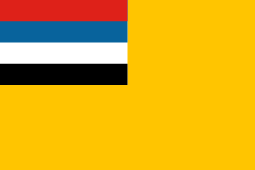


.svg.png)
.svg.png)
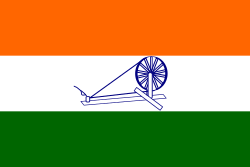
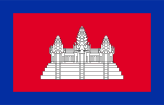
.svg.png)
.svg.png)
Imperial rule
The ideology of the Japanese colonial empire, as it expanded dramatically during the war, contained two contradictory impulses. On the one hand, it preached the unity of the Greater East Asia Co-Prosperity Sphere, a coalition of Asian races, directed by Japan, against the imperialism of the United Kingdom, France, the Netherlands, the United States, and European imperialism in general. This approach celebrated the spiritual values of the East in opposition to the crass materialism of the West.[29] In practice, however, the Japanese installed organizationally-minded bureaucrats and engineers to run their new empire, and they believed in ideals of efficiency, modernization, and engineering solutions to social problems.[30]
Japan set up puppet regimes in Manchuria and China; they vanished at the end of the war. The Imperial Army operated ruthless governments in most of the conquered areas, but paid more favorable attention to the Dutch East Indies. The main goal was to obtain oil. The Dutch destroyed their oil wells but the Japanese reopened them. However most of the tankers taking oil to Japan were sunk by American submarines, so Japan's oil shortage became increasingly acute. Japan sponsored an Indonesian nationalist movement under Sukarno.[31] Sukarno finally came to power in the late 1940s after several years of battling the Dutch.[32]
Philippines
With a view of building up the economic base of the Co-Prosperity Sphere, the Japanese Army envisioned using the Philippine islands as a source of agricultural products needed by its industry. For example, Japan had a surplus of sugar from Taiwan, and a severe shortage of cotton, so they tried to grow cotton on sugar lands with disastrous results. They lacked the seeds, pesticides, and technical skills to grow cotton. Jobless farm workers flocked to the cities, where there was minimal relief and few jobs. The Japanese Army also tried using cane sugar for fuel, castor beans and copra for oil, Derris for quinine, cotton for uniforms, and abacá for rope. The plans were very difficult to implement in the face of limited skills, collapsed international markets, bad weather, and transportation shortages. The program was a failure that gave very little help to Japanese industry, and diverted resources needed for food production.[33] As Karnow reports, Filipinos "rapidly learned as well that 'co-prosperity' meant servitude to Japan's economic requirements".[34]
Living conditions were bad throughout the Philippines during the war. Transportation between the islands was difficult because of a lack of fuel. Food was in very short supply, with sporadic famines and epidemic diseases that killed hundreds of thousands of people.[35][36] In October 1943, Japan declared the Philippines an independent republic. The Japanese-sponsored Second Philippine Republic headed by President José P. Laurel proved to be ineffective and unpopular as Japan maintained very tight controls.[37]
Failure
The Co-Prosperity Sphere collapsed with Japan's surrender to the Allies in September 1945. Although Japan succeeded in stimulating anti-Westernism in most of Asia, the sphere never materialized into a unified Asia. Dr. Ba Maw, wartime President of Burma under the Japanese, blamed the Japanese military:
The militarists saw everything only in a Japanese perspective and, even worse, they insisted that all others dealing with them should do the same. For them there was only one way to do a thing, the Japanese way; only one goal and interest, the Japanese interest; only one destiny for the East Asian countries, to become so many Manchukuos or Koreas tied forever to Japan. These racial impositions ... made any real understanding between the Japanese militarists and the people of our region virtually impossible.[38]
In other words, the Greater East Asia Co-Prosperity Sphere operated not for the betterment of all the Asian countries, but rather for Japan's own interests, and thus the Japanese failed to gather support in other Asian countries. Nationalist movements did appear in these Asian countries during this period and these nationalists did, to some extent, cooperate with the Japanese. However, Willard Elsbree, professor emeritus of political science at Ohio University, claims that the Japanese government and these nationalist leaders never developed "a real unity of interests between the two parties, [and] there was no overwhelming despair on the part of the Asians at Japan's defeat".[39]
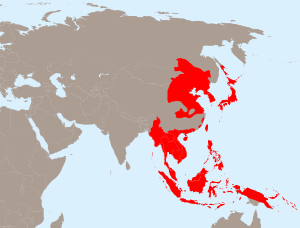
The failure of Japan to understand the goals and interests of the other countries involved in the Greater East Asia Co-Prosperity Sphere led to a weak association of countries bound to Japan only in theory and not in spirit. Dr. Ba Maw argues that Japan could have engineered a very different outcome if the Japanese had only managed to act in accord with the declared aims of "Asia for the Asiatics". He argues that if Japan had proclaimed this maxim at the beginning of the war, and if the Japanese had actually acted on that idea,
No military defeat could then have robbed her of the trust and gratitude of half of Asia or even more, and that would have mattered a great deal in finding for her a new, great, and abiding place in a postwar world in which Asia was coming into her own.[40]
Propaganda efforts
Pamphlets were dropped by airplane on the Philippines, Malaya, North Borneo, Sarawak, Singapore, and Indonesia, urging them to join this movement.[41] Mutual cultural societies were founded in all conquered nations to ingratiate with the natives and try to supplant English with Japanese as the commonly used language.[42] Multi-lingual pamphlets depicted many Asians marching or working together in happy unity, with the flags of all the nations and a map depicting the intended sphere.[43] Others proclaimed that they had given independent governments to the countries they occupied, a claim undermined by the lack of power given these puppet governments.[44]
In Thailand, a street was built to demonstrate it, to be filled with modern buildings and shops, but 9⁄10 of it consisted of false fronts.[45] A network of Japanese-sponsored film production, distribution, and exhibition companies extended across the Japanese Empire and was collectively referred to as the Greater East Asian Film Sphere. These film centers mass-produced shorts, newsreels, and feature films to encourage Japanese language acquisition as well as cooperation with Japanese colonial authorities.[46]
Projected territorial extent
Prior to the escalation of World War II to the Pacific and East Asia, the Japanese planners regarded it as self-evident that the conquests secured in Japan's earlier wars with Russia (South Sakhalin and Kwantung), Germany (South Seas Mandate) and China (Manchuria) would be retained, as well as Korea (Chōsen), Taiwan (Formosa), the recently seized additional portions of China and occupied French Indochina.[47]
The Land Disposal Plan
A reasonably accurate indication as to the geographic dimensions of the Co-Prosperity Sphere are elaborated on in a Japanese wartime document prepared in December 1941 by the Research Department of the Imperial Ministry of War.[47] Known as the "Land Disposal Plan in the Greater East Asia Co-Prosperity Sphere" (大東亜共栄圏における土地処分案)[48] it was put together with the consent of and according to the directions of the Minister of War (later Prime Minister) Hideki Tōjō. It assumed that the already established puppet governments of Manchukuo, Mengjiang, and the Wang Jingwei regime in Japanese-occupied China would continue to function in these areas.[47] Beyond these contemporary parts of Japan's sphere of influence it also envisaged the conquest of a vast range of territories covering virtually all of East Asia, the Pacific Ocean, and even sizable portions of the Western Hemisphere, including in locations as far removed from Japan as South America and the eastern Caribbean.[47]
Although the projected extension of the Co-Prosperity Sphere was extremely ambitious, the Japanese goal during the "Greater East Asia War" was not to acquire all the territory designated in the plan at once, but to prepare for a future decisive war some 20 years later by conquering the Asian colonies of the defeated European powers, as well as the Philippines from the United States.[49] When Tōjō spoke on the plan to the House of Peers he was vague about the long-term prospects, but insinuated that the Philippines and Burma might be allowed independence, although vital territories such as Hong Kong would remain under Japanese rule.[26]
The Micronesian islands that had been seized from Germany in World War I and which were assigned to Japan as C-Class Mandates, namely the Marianas, Carolines, Marshall Islands, and several others do not figure in this project.[47] They were the subject of earlier negotiations with the Germans and were expected to be officially ceded to Japan in return for economic and monetary compensations.[47]
The plan divided Japan's future empire into two different groups.[47] The first group of territories were expected to become either part of Japan or otherwise be under its direct administration. Second were those territories that would fall under the control of a number of tightly-controlled pro-Japanese vassal states based on the model of Manchukuo, as nominally "independent" members of the Greater East Asian alliance.

Parts of the plan depended on successful negotiations with Nazi Germany and a global victory by the Axis powers. After Germany and Italy declared war on the United States on 11 December 1941, Japan presented the Germans with a drafted military convention that would specifically delimit the Asian continent by a dividing line along the 70th meridian east longitude. This line, running southwards through the Ob River's Arctic estuary, southwards to just east of Khost in Afghanistan and heading into the Indian Ocean just west of Rajkot in India, would have split Germany's Lebensraum and Italy's spazio vitale territories to the west of it, and Japan's Greater East Asia Co-Prosperity Sphere and its other areas to the east of it.[50] The plan of the Third Reich for fortifying its own Lebensraum territory's eastern limits, beyond which the Co-Prosperity Sphere's northwestern frontier areas would exist in Northeast Asia, involved the creation of a "living wall" of Wehrbauer "soldier-peasant" communities defending it. However, it is unknown if the Axis powers ever formally negotiated a possible, complementary second demarcation line that would have divided the Western Hemisphere.
Japanese-governed
- Government-General of Formosa
- Hong Kong, the Philippines, Portuguese Macau (to be purchased from Portugal), the Paracel Islands, and Hainan Island (to be purchased from the Chinese puppet regime). Contrary to its name it was not intended to include the island of Formosa (Taiwan).
- South Seas Government Office
- Guam, Nauru, Ocean Island, the Gilbert Islands and Wake Island
- Melanesian Region Government-General or South Pacific Government-General
- British New Guinea, Australian New Guinea, the Admiralties, New Britain, New Ireland, the Solomon Islands, the Santa Cruz Archipelago, the Ellice Islands, the Fiji Islands, the New Hebrides, New Caledonia, the Loyalty Islands, and the Chesterfield Islands
- Eastern Pacific Government-General
- Hawaii Territory, Howland Island, Baker Island, the Phoenix Islands, the Rain Islands, the Marquesas and Tuamotu Islands, the Society Islands, the Cook and Austral Islands and Pukapuka, all of the Samoan Islands, Tokelau, Tonga and the Chilean islands of Rapa Nui and Sala y Gómez. The possibility of re-establishing the defunct Kingdom of Hawaii was also considered, based on the model of Manchukuo.[51] Those favoring annexation of Hawaii (on the model of Karafuto) intended to use the local Japanese community, which had constituted 43% (c. 160,000) of Hawaii's population in the 1920s, as a leverage.[51] Hawaii was to become self-sufficient in food production, while the Big Five corporations of sugar and pineapple processing were to be broken up.[52] No decision was ever reached regarding whether Hawaii would be annexed to Japan, become a puppet kingdom, or be used as a bargaining chip for leverage against the US.[51]
- Australian Government-General
- All of Australia including Tasmania. Australia and New Zealand were to accommodate up to two million Japanese settlers.[51] However, there are indications that the Japanese were also looking for a separate peace with Australia, and a satellite rather than colony status similar to that of Burma and the Philippines.[51]
- New Zealand Government-General
- The New Zealand North and South Islands, Macquarie Island, as well as the rest of the Southwest Pacific
- Ceylon Government-General
- All of India below a line running approximately from Portuguese Goa to the coastline of the Bay of Bengal
- Alaska Government-General
- The Alaska Territory, the Yukon Territory, the western portion of the Northwest Territories, Alberta, British Columbia, and Washington. There were also plans to make the American West Coast (comprising California and Oregon) a semi-autonomous satellite state. This latter plan was not seriously considered; it depended upon a global victory of Axis forces.[51]
Asian puppet states
- Manchukuo
- Manchuria
- Mengjiang
- Outer Mongolia territories west of Manchuria
- Republic of China
- Parts of China occupied by Japan
- East Indies Kingdom
- Dutch East Indies, British Borneo, and Christmas Islands, the Andaman and Nicobar Islands, and Portuguese Timor (to be purchased from Portugal)
- State of Burma
- Burma proper, Assam (a province of the British Raj) and large part of Bengal
- Kingdom of Malaya
- Remainder of the Malay states
- Kingdom of Cambodia
- Cambodia and parts of French Cochinchina
- Kingdom of Annam
- Annam, Laos, and Tonkin
- Empire of Vietnam
Independent member states
Thailand, and parts of Cambodia, Laos, and Burma that it had lost to the British and French
India, excluding the Southern portion that would go to Japan
Political parties and movements with Japanese support
- Azad Hind (Indian nationalist movement)
- Indian Independence League (Indian nationalist movement)
- Indonesian Nationalist Party (Indonesian nationalist movement)
- Kapisanan ng Paglilingkod sa Bagong Pilipinas (Philippine nationalist ruling party of the Second Philippine Republic)
- Kesatuan Melayu Muda (Malayan nationalist movement)
- Khmer Issarak (Cambodian-Khmer nationalist group)
- Dobama Asiayone (We Burmans Association) (Burmese anti-British nationalist association)
The Great East Asia Co-Prosperity Sphere (GEACPS): Review of the Japanese Government Document
The unity of nations offers political, economic, and social benefits to the member nations. Unity is evident in unions such as the United States of America and the European Union. During World War II, Japan also intended to create such unity for Asian countries.
Japan wanted to enforce the Imperial Way on the people and resources of East Asia. The affected countries were those in the Pacific, Indian Ocean, and Central Asia regions. The nations included Japan, China, India, and Manchuria. Japan intended to 'delivering' these nations from the rule of America and Europe. These countries would be guided by peace and prosperity for all, unlike in the Western nations where individuals 'fight' each other for success. However, it is important to note that the establishment would be for the benefit of Japan more than other nations. The Imperial Way was a law by the Japanese system, and thus, little consideration was given for the laws of other governments.
The Imperial government wanted to establish an Imperial Way across East Asia and abandon the spreading 'Western individualism and materialism.' This plan required driving out the British and American people out of the region. The drafters believed that the Westerns were responsible for the issues in the region. America and Europe usually follow an individualistic philosophy.
Individualism believes in the promotion of individual interest. In Western nations, it is a common practice where people compete with each other for individual benefit. The Japanese government saw this practice as detrimental to the development of East Asia. This is because individualism creates a gap between the rich as the poor. Also, the competition for self-success comes at the cost of loss of welfare for others. For instance, the rich will oppress the poor so as to maintain their wealth level.
The achievement of individualism is guided by materialism, that is, the greed for more wealth without regard to others. Materialism values physical possession than spiritual 'wealth.' It considers wealth as the core life objective. These beliefs contradicted the Imperial Way, which was concerned about spiritual well-being. It believes that wealth comes second to human interests, such as peace and love. Therefore, the Imperial Way differed from Western individualism and materialism by purporting to support unity and prosperity for all.
The drafters believed that materialism was one of the causes of conflict, and more specifically, World War I and II. As each nation wants to increase its wealth, it reaches a limit where any additional increase will require taking up some of the property of the neighbor. The neighbor – in the protection of their property – responds violently. As a result, the neighbors go to war. The Japanese government believed that greed is what had pushed the Westerns into exploiting Asia’s wealth. The empire thus believed that the Imperial way could eliminate national conflict. People would not work to increase individual wealth but rather the community’s wealth. As a result, conflict can be avoided, and peace and prosperity for all would prevail.
In conclusion, the Japanese government purported to be opposing individualism and materialism. However, through uniting the East Asian nation, the empire would be separating itself from other regions. The Japanese government wanted to maintain wealth in the regions and only use the resources for improving the lives of the Asiana. Therefore, while within the region, there would be no individualism, from a global perspective, Japan would have developed itself as self-reliant, thus creating individualism from other regions of the world. Furthermore, it would create wealth for its member nations. Thus, through unity, the empire would still be promoting individualism and materialism from a regional perspective.
See also
- Japanese nationalism
- Imperial Rule Assistance Association
- Hachirō Arita: an Army thinker who thought up the Greater East Asian concept
- Satō Nobuhiro: the alleged developer of the Greater East Asia concept
- Ikki Kita: a Japanese nationalist who developed a similar pan-Asian concept
- East Asia Development Board
- Ministry of Greater East Asia
- Greater East Asia Conference (November 1943)
- List of East Asian leaders in the Japanese sphere of influence (1931–1945)
- Jewish settlement in the Japanese Empire
- Axis power negotiations on the division of Asia
- Hakkō ichiu
- Flying geese paradigm
- Racial Equality Proposal
- Greater Germanic Reich
References
Citations
- Matthiessen, Sven (2015). Japanese Pan-Asianism and the Philippines from the Late Nineteenth Century to the End of World War II: Going to the Philippines Is Like Coming Home?. BRILL. ISBN 9789004305724.
- De Bary, William T. (2008). Sources of East Asian Tradition: The modern period. Columbia University Press. p. 622. ISBN 9780231143233.
- Toland, John (1970). The Rising Sun: The Decline and Fall of the Japanese Empire, 1936-1945 (Modern Library paperback ed.). New York: Modern Library. pp. 447-448. ISBN 9780812968583. OCLC 52441692.
It had been created by idealists who wanted to free Asia from the white man. As with many dreams, it was taken over and exploited by realists... Corrupted as the Co-Propserity Sphere was by the militarists and their nationalist supporters, its call for pan-asianism remained relatively undiminished
- Dower, John W. (1986). War Without Mercy: Race & Power in the Pacific War (1st ed.). New York: Pantheon Books. pp. 263–264. ISBN 039450030X. OCLC 13064585.
- Dower, John W. (1986). War Without Mercy: Race & Power in the Pacific War (1st ed.). New York: Pantheon Books. pp. 262–290. ISBN 039450030X. OCLC 13064585.
- 第二次近衛声明
- Institute of Southeast Asian Studies (2006), Asian security reassessed, pp. 48-49, 63, ISBN 981-230-400-2
- John Toland, The Rising Sun: The Decline and Fall of the Japanese Empire 1936-1945 p 447 Random House New York 1970
- James L. McClain, Japan: A Modern History p 494 ISBN 0-393-04156-5
- John Toland, The Rising Sun: The Decline and Fall of the Japanese Empire 1936-1945 p 449 Random House New York 1970
- Iriye, Akira. (1999). Pearl Harbor and the coming of the Pacific War: a Brief History with Documents and Essays, p. 6.
- Ugaki, Matome. (1991). Fading Victory: The Diary of Ugaki Matome, 1941–1945
- James L. McClain, Japan: A Modern History p 470 ISBN 0-393-04156-5
- James L. McClain, Japan: A Modern History p 460 ISBN 0-393-04156-5
- James L. McClain, Japan: A Modern History p 461-2 ISBN 0-393-04156-5
- Vande Walle, Willy et al. The 'money doctors' from Japan: finance, imperialism, and the building of the Yen Bloc, 1894–1937 Archived 28 December 2010 at the Wayback Machine (abstract). FRIS/Katholieke Universiteit Leuven, 2007-2010.
- Anthony Rhodes, Propaganda: The art of persuasion: World War II, pp. 252–253, 1976, Chelsea House Publishers, New York
- William L. O'Neill, A Democracy at War: America's Fight at Home and Abroad in World War II. Free Press, 1993, p. 53. ISBN 0-02-923678-9
- William L. O'Neill, A Democracy at War, p. 62.
- Anthony Rhodes, Propaganda: The art of persuasion: World War II, p. 248, 1976, Chelsea House Publishers, New York
- James L. McClain, Japan: A Modern History p 471 ISBN 0-393-04156-5
- James L. McClain, Japan: A Modern History p 495 ISBN 0-393-04156-5
- Beasley, William G. (1990). The Rise of Modern Japan. New York: St. Martin's Press. pp. 79-80. ISBN 0312040784. OCLC 20722016.
- John W. Dower, War Without Mercy: Race & Power in the Pacific War pp. 24–25 ISBN 0-394-50030-X
- Levine, Alan J. (1995). The Pacific War: Japan Versus the Allies. Westport: Praeger. ISBN 0275951022. OCLC 31516895.
- W. G. Beasley, The Rise of Modern Japan, p 204 ISBN 0-312-04077-6
- Andrew Gordon, A Modern History of Japan: From Tokugawa to the Present, p. 211, ISBN 0-19-511060-9, OCLC 49704795
- "Greater East Asia Conference". World War II Database. Retrieved 20 November 2019.
- Jon Davidann, "Citadels of Civilization: U.S. and Japanese Visions of World Order in the Interwar Period", in Richard Jensen, et al. eds., Trans-Pacific Relations: America, Europe, and Asia in the Twentieth Century (2003) pp. 21–43
- Aaron Moore, Constructing East Asia: Technology, Ideology, and Empire in Japan's Wartime Era, 1931–1945 (2013) 226–227
- Laszlo Sluimers, "The Japanese military and Indonesian independence", Journal of Southeast Asian Studies (1996) 27#1 pp. 19–36
- Bob Hering, Soekarno: Founding Father of Indonesia, 1901–1945 (2003)
- Francis K. Danquah, "Reports on Philippine Industrial Crops in World War II from Japan's English Language Press", Agricultural History (2005) 79#1 pp. 74–96 in JSTOR
- Stanley Karnow, In Our Image: America's Empire in the Philippines (1989) pp. 308–309
- Satoshi Ara, "Food supply problem in Leyte, Philippines, during the Japanese Occupation (1942–44)", Journal of Southeast Asian Studies (2008) 39#1 pp 59–82.
- Francis K. Danquah, "Japan's Food Farming Policies in Wartime Southeast Asia: The Philippine Example, 1942-1944", Agricultural History (1990) 64#3 pp. 60-80 in JSTOR
- "World War II" in Ronald E. Dolan, ed. Philippines: A Country Study (1991)
- Lebra, Joyce C. (1975). Japan's Greater East Asia Co-Prosperity Sphere in World War II: Selected Readings and Documents, p. 157.
- Lebra, p. 160.
- Lebra, p. 158.
- Anthony Rhodes, Propaganda: The art of persuasion: World War II, p253 1976, Chelsea House Publishers, New York
- Anthony Rhodes, Propaganda: The art of persuasion: World War II, p254 1976, Chelsea House Publishers, New York
- "Japanese Propaganda Booklet from World War II"
- "JAPANESE PSYOP DURING WWII"
- Edwin P. Hoyt, Japan's War, p 326 ISBN 0-07-030612-5
- Baskett, Michael (2008). The Attractive Empire: Transnational Film Culture in Imperial Japan. Honolulu: University of Hawai'i Press. ISBN 9781441619709. OCLC 436157559.
- Weinberg, L. Gerhard. (2005). Visions of Victory: The Hopes of Eight World War II Leaders p.62-65.
- 検察側文書 1987 号、法廷証 679 号(1946 年 10 月 9 日付速記録)
- Storry, Richard (1973). The double patriots; a study of Japanese nationalism. Westport: Greenwood Press. pp. 317–319. ISBN 0837166438. OCLC 516227.
- Norman, Rich (1973). Hitler's War Aims: Ideology, the Nazi State, and the Course of Expansion. W.W. Norton & Company Inc. p. 235.
- Levine (1995), p. 92
- Stephan, J. J. (2002), Hawaii Under the Rising Sun: Japan's Plans for Conquest After Pearl Harbor, p. 159, ISBN 0-8248-2550-0
Further reading
- Baskett, Michael (2008). The Attractive Empire: Transnational Film Culture in Imperial Japan. Honolulu: University of Hawai'i Press. ISBN 978-0-8248-3223-0.
- Dower, John W. (1986). War Without Mercy: Race and Power in the Pacific War. New York: Pantheon Books. ISBN 978-0-394-50030-0; OCLC 13064585
- Fisher, Charles A. (1950) "The Expansion of Japan: A Study in Oriental Geopolitics: Part II. The Greater East Asia Co-Prosperity Sphere." The Geographical Journal (1950): 179–193.
- Iriye, Akira. (1999). Pearl Harbor and the coming of the Pacific War :a Brief History with Documents and Essays. Boston: St. Martin's Press. ISBN 978-0-312-21818-8; OCLC 40985780
- Lebra, Joyce C. (ed.) (1975). Japan's Greater East Asia Co-Prosperity Sphere in World War II: Selected Readings and Documents. Oxford: Oxford University Press. ISBN 978-0-19-638265-4; OCLC 1551953
- Levine, Alan J. (1995). The Pacific War:Japan versus the allies (Greenwood Publishing Group, ISBN 0-275-95102-2)
- Myers, Ramon Hawley and Mark R. Peattie. (1984) The Japanese Colonial Empire, 1895-1945. Princeton: Princeton University Press. ISBN 978-0-691-10222-1
- Peattie, Mark R. (1988). "The Japanese Colonial Empire, 1895-1945," in The Cambridge History of Japan: the Twentieth Century (editor, Peter Duus). Cambridge: Cambridge University Press. ISBN 978-0-521-22357-7
- Swan, William L. (1996) in JSTOR "Japan's Intentions for Its Greater East Asia Co-Prosperity Sphere as Indicated in Its Policy Plans for Thailand" Journal of Southeast Asian Studies 27#1 (1996) pp. 139–149
- Ugaki, Matome. (1991). Fading Victory: The Diary of Ugaki Matome, 1941-1945. Pittsburgh: University of Pittsburgh Press. ISBN 978-0-8229-3665-7
- Vande Walle, Willy et al. The 'money doctors' from Japan: finance, imperialism, and the building of the Yen Bloc, 1894–1937 (abstract). FRIS/Katholieke Universiteit Leuven, 2007–2010.
External links
| Wikimedia Commons has media related to Greater East Asia Co-Prosperity Sphere. |
